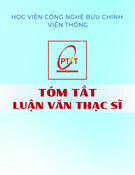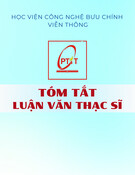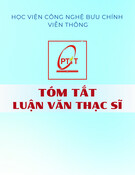HUE UNIVERSITY
COLLEGE OF SCIENCES
NGUYEN KIM QUOC
RESEARCH IMPROVED CONTROL MECHANISMS AT THE NETWORK NODES
MAJOR: COMPUTER SCIENCE CODE: 62.48.01.01
ABSTRACT OF THE THESIS
NGƯỜI HƯỚNG DẪN KHOA HỌC:
1. GS. TS. NGUYỄN THÚC HẢI
HUE, 2015
The thesis had implemented at College of Sciences, Hue University
Academic Supervisor:
Prof. Dr. Nguyen Thuc Hai Assoc. Prof. Dr. Vo Thanh Tu
Reviewer 1: ............................................................................................................ .............................................................................................................. Reviewer 2: ............................................................................................................ .................................................................................................................................. Reviewer 3: ............................................................................................................ ..................................................................................................................................
This thesis will be reported at Hue University Date & Time …./ …./…./….
The thesis can be found at: 1. National Library of Vietnam, Hanoi 2. Learning Resource Centers - Hue University 3. Center for Information and Library, College of Sciences, Hue University
1
PREFACE
Internet is a global networking system which ensures a continuity between computer systems and equipment on a large scale. Internet is growing not only in the terms of connection but also diversity of the application layers. Therefore, Internet congestion is inevitable. In order that transmission lines may be smooth, congestion control at the network nodes plays a very important role for the Internet operational efficiency and reliability for users. To study and improve congestion control mechanism at the network nodes, the introduction of the thesis comes from general research of domestic and international control situation of congestion at the network nodes in order to show the scientific and necessary nature of the thesis. Thence, the thesis may set out the study motivation and study goals. Next, the thesis has proposed study methodology and study subjects, in order to perform the study goals and finally the introduction presents the layout and contributions of the thesis. 1. Scientific and necessary nature of the thesis
There are two common options for congestion control which consists of improving the capacity of hardware devices and using software techniques. Improving the capacity of hardware devices is necessary, but it is so costly, hard to be sync and the efficiency is still not high. However, using software techniques to control congestion is highly efficient. In this technique, there are two methods of interest and development, including: improving the communication controlling protocols and advancing AQM: Active Queue Management at the network nodes [17] [28] [55]. The increase of TCP performance through variations has been deployed on the Internet and has brought enormous efficiency. However, due to the multi-standard of network types, the abundance of connecting devices and the complexity of communication applications, so it is important to have mechanisms to (AQM) active queue management at the network nodes to support regulate traffic on the network, in order to avoid and resolve congestion [7][10][51].
Active queue management (AQM) at the network nodes in order to control the number of data packets in the queue of the network nodes, by actively removing the packets until the queue is full or congestion notification when the network is in the "embryo" period of congestion to regulate traffic on the network. The stability of the queue length will make some performance parameters of TCP/IP network, such as packet loss ratio, transmission efficiency, average latency and latency variability fluctuated in a reasonable range. This will both ensure no congestion on the network and facilitate to provide and maintain the best quality of network services [7] [39] [62].
There are three approaches to solve the active queue management problem, including: Queue management based on queue length (typically RED mechanism) [22][25] [67], queue management based on packet flow to - also called traffic load (represented as BLUE mechanism) [24] [73] and queue management based on the combination of the queue length and packet flow to (typically REM mechanism) [57] [65]. In recent years, in order to improve the performance of the active queue management, in addition to the typical three mechanisms mentioned above, there are many other mechanisms announced. The works revolve around the improvement of RED, BLUE and REM mechanisms[18][26][54]. The obtained results have partially met the requirements of the problem of active queue management [54][66]. However, active queue management mechanisms is still some inherent disadvantages, such as using the linear function to determine the level of congestion and probabilistic marking/dropping the packet; and difficult to install the parameters for mechanisms to suit each different network environment [39] [59] [76].
2
Soft Computing (SC) includes tools: fuzzy logic, neural networks, probabilistic reasoning, evolutionary computation. The objective of Soft Computing is to solve problems of approximation, approximation which is a new trend, allowing a specific problem to be exploited with the goal that the system is easy to design, low cost while ensuring accuracy and intelligence in the implementation process with an acceptable error threshold. The successful applications of Soft Computing show Soft Computing is growing strongly and playing an important role in various fields of science and engineering [36][45]. In Soft Computing Technique, fuzzy logic is considered as the best tool to achieve human knowledge, thanks to the membership functions and fuzzy systems. Therefore, fuzzy logic is used widely in many fields, especially in the field of automatic control [5] [8]. Besides, fuzzy logic, with strengths in updating knowledge through the training process to neural networks is widely and commonly used, especially in the field of computer science [53] [68].
Because of the superiority of Soft Computing so that scientists have used soft computing tools to improve software active queue management mechanisms at the network nodes in recent years [23][32][50][78]. However, there should be a combination of Soft Computing tools to promote its advantages and reduce its disadvantages for the tools to build active queue management mechanisms. Thus, these mechanisms still need to be improved so that they are simpler, flexible to control, adaptive to the network environment when implementing, ensuring fairness in obtaining or removing packets for with the arrival flow streams and maintaining its average queue length in terms of changeable network. Thus, studying to improve queue active queue management mechanisms, by combining the Soft Computing skills and modern control methods to supplement processing capabilities, the ability to make smart decisions for active queue management system at network nodes is essential and urgent. 2. Motivation of study
First, linearity of the control function of the mechanism cannot be grasped for effective control of the network and nonlinear dependence of the mechanism on static parameters cannot be adapted to changeable network status. This issue is solved by fuzzy control method in the thesis.
Second, most active queue management mechanisms have not referred to the impact of the elements in the network on the congestion controlling process, so the control of mechanisms cannot be well adaptive to the network environment. Therefore, the thesis uses adaptive fuzzy control technique to overcome such problems.
Third, recently some mechanisms of active queue management have used fuzzy reasoning to join the queue management but fuzzy control system of these mechanisms depend heavily on experts and its parameters are not addressed Update in response to each different network conditions. Therefore, the thesis applies optimized fuzzy controlling method by training the system, keeps the system following the network’s changing environment so that the mechanism can work more effectively. 3. Thesis goals
First is studying and evaluation of active queue management mechanisms to find out the advantages and disadvantages of each mechanism, in order to classify and evaluate application performance for mechanisms and using fuzzy logic to improve active queue management mechanism. The results of the first goals is to perform study motivation first and will be the foundation for the theory and simulation improvements of the thesis.
Second is basing on the analysis and evaluation of active queue management mechanisms in the first goal, combining theory of dynamical system control, fuzzy control and adaptive
control techniques to build adaptive fuzzy control, to improve active queue management mechanisms. The results of this goal is to resolve existing problems in the second study motivation of the thesis.
3
Third is combining fuzzy reasoning and neural networks to build fuzzy neural system in order to better improve queue active management mechanisms improved in the second goal, namely that building FUZZY NEURAL NETWORK (FNN) to enhance the performance of the mechanisms improved from AFC. The outcome of this goal is to implement the third study motivation of the thesis. 4. Study method
To achieve these goals, the study method in the thesis is closely combined between theoretical research and proven simulation settings. This method using the study objects consisting of the typical active queue management mechanisms, control theory, Soft Computing skills and two simulated software, Matlab and NS2 [40] which are trusted by scientific researchers. 5. Thesis layout
With the goals and methods of the study mentioned above, the thesis content is outlined into three chapters.
Chapter 1: Congestion control in TCP/IP network upon active queue management at network nodes – The chapter’s beginning section will present the TCP congestion control and its variants over TCP/IP network. Thence, clarifying the importance of active queue management mechanisms in congestion control in TCP/IP network. The next section of the chapter will update, analyze, evaluate and classify application of typical active queue management mechanisms and fuzzy control applied to improve these mechanisms. Thereby, the thesis gives out the existing issues in the existing active queue management mechanisms and proposes the ideas of building adaptive fuzzy control model to the problem improving active queue management mechanisms in the network nodes at the end of the chapter.
Chapter 2: Improvement of active queue management mechanisms upon adaptive fuzzy control – The chapter’s beginning section presents the mathematical foundations of fuzzy logic, the next of the chapter is to survey, to assess active queue management mechanisms with the application of fuzzy control. Thence, the thesis models (AFC) adaptive fuzzy control to overcome the limitations of previous proposals. Basing on theoretical models, the thesis carries out the construction and simulation installation of improved FLRED and FLREM mechanisms. In particular, FIRED mechanism is improved from RED mechanism, FLREM mechanism improved from REM mechanism. The next part of the program is the simulation evaluation of the proposed mechanism compared to existing mechanisms. The last part of the chapter is the conclusion of the AFC significance in improving mechanism of active queue management, while pointing out the limitations of AFC and setting out the need to use neural networks to adjust the parameters of AFC.
Chapter 3: Integrated fuzzy reasoning and neural networks to enhance performance of active queue management - The first section of the chapter presents the mathematical basis of neural networks. Thence, the thesis models fuzzy neural network (FNN) by integrating fuzzy control with neural networks in order to improve active queue management mechanisms. During network training, to have good academic results, the thesis proposes to use Improved Back Propagation (IBP). Basing on the theoretical model, the thesis builds innovative mechanisms of FNNRED, FNNREM. In particular, FNNRED mechanism is improved from FLRED mechanism and FNNREM is improved from FLREM mechanism.
The next part of the chapter is the simulation and evaluation of the proposed mechanisms compared to the mechanisms using adaptive fuzzy control AFC and mechanisms using fuzzy controller. The last section of the chapter confirms the role of fuzzy neural network (FNN) to enhance performance of active queue management.
4
Finally, the conclusion, summary of the author's new proposals to implement the goals of the thesis. In addition, the author also offers the expected studying areas and results in the future. 6. Thesis’s contributions
From the study results on the theory and demonstration through simulation, the thesis has made some specific contributions as follows:
Making application layers for existing active queue management mechanisms, and using ECN technology to improve active queue management mechanisms, the result has been published in the works [CT1][CT2]. Using the fuzzy controller to improve active queue management mechanisms, the result has been published in the works [CT3] [CT5] [CT6].
Building (AFC) adaptive fuzzy control model to improve the active queue management mechanisms at the network nodes, the result has been published in the works [CT8].
Building (RFN) fuzzy neural network model to improve the efficiency of the active queue management mechanisms at the network nodes, the result has been published in the works [CT4] [CT7].
From the above results, the thesis shows the improvement role of queue management mechanisms in the network nodes and the potential application of soft computing technique to solve the larger problems in TCP/IP.
CHAPTER 1.
CONGESTION CONTROL IN TCP/IP NETWORK UPON
ACTIVE QUEUE MANAGEMENT AT NETWORK NODES
1.1. Congestion control in TCP/IP network
1.1.1. Operating model of TCP/IP network
1.1.1.1. Communication model in TCP/IP network
1.1.1.2. Mathematical model of TCP/IP network
1.1.2. Congestion in TCP/IP network
1.1.2.1. Congestion Causes
1.1.2.2. Principles of congestion control
1.1.2.3. Congestion control techniques
1.1.3. Congestion control of TCP
1.1.4. Congestion control with queue management
1.1.5. Active queue management
The most important goal of active queue management mechanism is to prevent congestion before it actually happens, maintain stable queue length in order to reduce the loss of the packets to achieve a high data transmission flow and a low latency queue [10] [17] [18].
5
1.1.5.1. Architecture of network nodes
1.1.5.2. Congestion control with active queue management
1.1.5.3. Advantages of active queue management
1.1.6. Explicit congestion notification technique
ECN: Explicit Congestion Notification is a technique that allows a network node to provide
clear feedback to the sender of congestion. 1.2. Analysis and evaluation of active queue management mechanisms
1.2.1. Queue management mechanism based on queue length
In the queue management mechanism based on queue length, the congestion phenomenon
is based on the instantaneous or average length of queue. 1.2.1.1. RED mechanism
In 1993, Sally Floyd and et al proposed RED mechanism [25][42] for early detection of congestion, RED controls congestion at network nodes by checking the average length of the queue when packets arrive and make decisions to receive the packets, mark or reject the packets. 1.2.1.2. FRED mechanism
In 1997, Dong Lin and et al proposed FRED mechanism [21] to improve RED mechanism
to reduce the unfair impact in queue. 1.2.2. Management mechanism based on traffic load
Active queue management mechanisms based on traffic load to predict linked the usability of transmission lines, identify congestion and provide remedies. This mechanism’s purpose is to regulate packet in network nodes to stabilize the arrival packets, in order to maintain network stability. The typical mechanisms for this group are: BLUE and SFB. 1.2.2.1. BLUE mechanism
In 2002, Wu-Chang Feng et al proposed BLUE mechanism [27][81]. The main idea of BLUE is to use a probability variable 𝑝𝑚 to mark the packets as they enter the queue. This probability increases/decreases linearly depending on the dropping ratio of packet or use of transmission line. 1.2.2.2. SFB mechanism
In 2001, Wu-Chang Feng et proposed SFB mechanism [72]. SFB divided queue into computing boxes, each box maintain a probability marking the packet 𝑝𝑚 similar BLUE. The boxes are organized into 𝐿 levels, each level has 𝑁 box. In addition, SFB uses 𝐿 independent hash functions, each function corresponds to one level. Each hash function reflects a stream into one of the boxes in such level. 1.2.3. Management mechanism based on queue length and traffic load
The active queue management mechanisms based on the queue length control and packet flow to the network nodes, to estimate the level of use of resources (queues and bandwidth), to determine the congestion state at the network nodes. Typical mechanisms for this group like REM and GREEN mechanisms [11] [57][71]. 1.2.3.1. REM mechanism
In 2001, Sanjeewa Athuraliya et al proposed REM mechanism [57] [75]. The idea of REM is to stabilize input load and link capacity of the queue, regardless of the number of users to
6
link share. 1.2.3.2. GREEN mechanism
In 2002, Apu Kapadia et al proposed GREEN mechanism [6][71]. GREEN mechanism applied knowledge of the stable behaviors of TCP connections in the network nodes to the fall (or mark) packets. 1.2.4. Performance evaluation and application classifier of AQM mechanism
1.2.4.1. Performance evaluation of AQM mechanism
Table 1.2. Performance evaluation of active queue management mechanisms
Mechanism
GREEN high low
Throughput Packet loss ratio Buffer space BLUE REM RED high medium high low high medium small medium small great
1.2.4.2. Application classifier of AQM mechanisms
1.3. Application classifier of active queue management mechanism
Mechanism RED BLUE REM GREEN
Based on queue length
Based on traffic load
Classifier
Based on transmission line efficiency Based on the information flow
Adaption
Strong Flow control Unadaptive Weak
1.3. Fuzzy logic application status in active queue management
The purpose of the application of fuzzy logic is to simplify the design of AQM algorithm based on a degree of tolerance. The application of fuzzy logic in active queue management mechanisms has been researched by many scientists in recent years. 1.3.1. RED Mechanisms using improved fuzzy logic
1.3.1.1. FEM Mechanism
In 2006, C. Chrysostomou et al proposed FEM mechanism [12][13]. FEM is built by
introducing fuzzy logic into RED mechanism. 1.3.1.2. FCRED Mechanism
In 2007, Jinsheng Sun et at proposed FCRED mechanism [34]. FCRED using a fuzzy controller to adjust the maximum dropping probability 𝑚𝑎𝑥𝑝 of RED, to increase the stability of the average queue length in the reference queue length range QT. 1.3.2. BLUE mechanism using improved fuzzy logic
1.3.2.1. Fuzzy BLUE Mechanism
7
In 2005, MH Yaghmaei et al proposed Fuzzy BLUE mechanism [47] to improve Fuzzy BLUE mechanism upon fuzzy logic. Fuzzy BLUE using packet loss ratio and queue usage ratio as input language variables and the packet dropping marking probability as output language variables. 1.3.2.2. DEEP BLUE Mechanism
In 2009, S. Masoumzadeh et al proposed DEEP BLUE mechanism [60] to improve BLUE mechanism. DEEP BLUE using probability to remove the packet and event of idle links for congestion control, as the input variables of the fuzzy controller and the output as variable 𝑚𝑎𝑥𝑝. 1.3.3. REM mechanism using improved fuzzy logic
1.3.3.1. FRAME Mechanism
In 2010, Y. Xian et al proposed FREM mechanism [32] [77], built on REM algorithm and fuzzy logic controller to mark and automatically release the packets, keep the queue length at the level around the reference value and prevent overflow queue. 1.3.3.2. FUZE Mechanism
In 2008, Xu Changbiao et al proposed FUZREM Mechanism [74] to improve the performance of REM mechanism upon opening argue. FUZREM using fuzzy Mamdani with triangular function, with 7 domains of value for the input and output variables, so its fuzzy rule system consists of 49 rules. 1.3.4. Improving queue management mechanism by fuzzy control
The following section introduces the improvement of BLUE mechanism and SFB mechanism by fuzzy controller. The RED and REM mechanisms are also improved by fuzzy controller, and improving performance through adaptive fuzzy control and fuzzy control optimization will be introduced in the next chapter of the thesis. 1.3.4.1. Improvement of BLUE mechanism
We develop FLBLUE mechanism [CT5] from the improvement of BLUE mechanism by fuzzy logic. Fuzzy controller of FLBLUE is fuzzy Mamdani with triangular/trapezoidal functions, with two inputs 𝐵𝑒(𝑘𝑇) and 𝐵𝑒(𝑘𝑇 − 𝑇) as the deviation of the current throughput against the objective throughput in the output of the bottleneck at two consecutive sampling times. 1.3.4.2. Improvement of SFB mechanism
inputs and encoded by two the
We have developed FSFB mechanism [CT3] from the improvement of SFB mechanism by using fuzzy controller, with two inputs as packet loss ratio and the using level of the queue to compute the output as the probability of packet marking. Two quantities of 𝑝𝑎𝑐𝑘𝑒𝑡 𝑙𝑜𝑠𝑠 (𝑡) and 𝑞𝑢𝑒𝑢𝑒 𝑙𝑒𝑛𝑔𝑡ℎ(𝑡) represent three domains (𝑙𝑜𝑤, 𝑚𝑒𝑑𝑖𝑢𝑚, ℎ𝑖𝑔ℎ) with trapezoidal function. 1.4. Several problems in active queue management mechanisms
Overall, the existing active queue management mechanisms often use the linear functions for calculating probabilities rejecting/ marking packets and comply with a fixed formula, it is not strong enough for the high network flow and cannot grasp the nonlinear and dynamical nature of TCP/IP network. This requirement can be achieved when using nonlinear method for probability rejecting/marking packets in the flexible approach through Soft computing techniques, such as fuzzy logic, neural networks, advanced computing, probabilistic reasoning.
8
The control systems using fuzzy reasoning to provide simple and efficient solutions to control the nonlinear conversion system over time, using a fuzzy inference to make the decision for probabilities rejecting or marking packets, which does not require much knowledge of the kinetic parameters of the system or network. Fuzzy control system for active queue management is able to work efficiently and stably to put the controlled object in a stable state as soon as possible.
In recent years, AQM mechanisms based on fuzzy logic has been proposed with the design process simpler than traditional AQM algorithms and for some better results in maintaining stability of the queue. However, the design of the fuzzy controllers still lacks adaptive components and depends heavily on the knowledge of experts. Therefore, there should be the adaptive fuzzy controllers and the ability to self-learn from the actual results of measurement of input/output of the system to obtain better parameters for the fuzzy controller, to increase efficiency of active queue management mechanisms. 1.5. Conclusion of the Chapter
This chapter has presented the congestion control mechanism for TCP/IP network and the importance of active queue management at the network nodes during the congestion control. Thence, analyzing the study status of the traditional queue management mechanism. Basing on the results of theoretical research and analysis of active queue management mechanisms, the thesis has made the performance evaluation and application Classifier to the mechanisms. Most of the methods of active queue management cannot meet all the goals, especially the goal to respond to change in non-linear and kinetics of TCP/IP network.
The last part of the chapter, the thesis has made some improvements for active queue management mechanisms upon fuzzy controller. However, these improvements are based on fuzzy Mamdani with triangular or trapezoidal functions to simplify in the calculation process, so the control process has not been smooth and the adaption to the network environment is not high. Therefore, it is necessary to continue improving the fuzzy controller to improve performance for the mechanism, by replacing Fuzzy Mamdani with a better one and adding adaptive components to better adapt to the actual condition of the network. These are the issues to be researched and developed in the following chapters.
CHAPTER 2.
IMPROVEMENT OF ACTIVE QUEUE MANAGEMENT
MECHANISMS UPON ADAPTIVE FUZZY CONTROL
2.1. Mathematical basis of fuzzy logic
2.1.1. Fuzzy set
Definition of 2.1 [30]. Give 𝑼 universe set. 𝐴 set is defined by the equation:
then 𝐴 called fuzzy set on 𝑼 set.
𝑢 variable takes the value of 𝑼 called basic variable and therefore, 𝑼 set also known as the reference set or basic domain.
𝜇𝐴: 𝑈 ⟶ [0,1] function is called IMF: Membership Function and 𝜇𝐴(𝑢) value at 𝑢 called
the likelihood of u element belonged to A fuzzy set. 2.1.2. Membership Functions for fuzzy set
The membership functions are built from the basic functions such as: first derivative,
9
trapezoidal, triangular, and Gaussian distribution function and bell function. 2.1.3. Typical parameters for fuzzy set
The parameters characterize the fuzzy set consisting of height (𝐻), domain of determinacy
(𝑆)confidence range (𝑇) 2.1.4. Calculations on fuzzy set
T-norm and S-norm
Definition of 2.2 [30]. A 2-variable function T: [0,1] [0,1] [0,1] known as T-norm
(T-norm) if it meets the following properties with 𝑎, 𝑎’, 𝑏, 𝑐 [0,1]:
Definition of 2.3 [30]. A 2-variable function S: [0,1] [0,1] [0,1] known as T-norm (S-
norm), if it meets the following properties with 𝑎, 𝑎’, 𝑏, 𝑐 [0,1]: Intersection of two fuzzy sets
The intersection of two fuzzy sets of 𝐴 and 𝐵 with the same basis 𝑋 is a fuzzy set of 𝐴 ∩ 𝐵 also determined on the basis of 𝑋 is determined by 𝑇 binary mapping, with the membership function as follows:
(2.14) 𝜇𝐴∩𝐵 = 𝑇(𝜇𝐴(𝑥), 𝜇𝐵(𝑥))
Union of two fuzzy sets
Combination of two fuzzy sets of 𝐴 and 𝐵 with the same basis 𝑋 is a fuzzy set of A ∪ B also determined on the basis of 𝑋 determined by 𝑆 binary mapping, with the membership function as follows:
(2.19) 𝜇𝐴∪𝐵 = 𝑆(𝜇𝐴(𝑥), 𝜇𝐵(𝑥))
Complement of a fuzzy set
Complement of 𝐴 fuzzy set has 𝑋 basis and 𝜇𝐴(𝑥) membership function is a fuzzy set of 𝐴̅ determined on the same basis 𝑋 with membership function:
(2.24) 𝜇𝐴̅(𝑥) = 1 − 𝜇𝐴(𝑥)
2.1.5. Fuzzy composition law
Language Variable
Definition of 2.4 [30]. Language variable is a five set (𝑥, 𝑇(𝑥), 𝑋, 𝑅, 𝑀), in which 𝑥 is variable name, 𝑇(𝑥) is the set of language values of variables 𝑥, 𝑋 a s the platform space, also known as the basic domain of variable 𝑥, 𝑅 as a rule generating the language values in 𝑇(𝑥), 𝑀 as an assigned semantic rules represented by fuzzy set on 𝑋 for the language words in 𝑇(𝑥). Fuzzy composition clause Fuzzy composite law 2.1.6. Defuzzification
Maximum method Focus Method 2.1.7. Fuzzy control
2.1.7.1. Model of fuzzy controller
10
Figure 2.4. Model of MISO fuzzy controller Theorem 2.1 (Multimeter theorem) [36]: Give 𝑦 = 𝑓(𝑥) multi-variable function with 𝑥 = (𝑥1, … , 𝑥𝑛)𝑇, continuity in the compact domain. Where, with every 𝜀 > 0 arbitrarily given, always exist fuzzy system 𝑔(𝑥) as Figure 2.4 so that |𝑓(𝑥) − 𝑔(𝑥)| < 𝜀.
The foregoing theorem is a basis of improving the existing active queue management mechanisms by model of fuzzy controller. In control engineering, MISO fuzzy controller structure is widely used with fuzzy Mamdani and fuzzy Sugeno. 2.1.7.2. Fuzzy Mamdani
𝑗 )AND … AND (𝑥𝑚 is A𝑚
𝑗 ) 𝑇𝐻𝐸𝑁 (𝑦1 is 𝐵1
𝑗 ) 𝑗), … , (𝑦𝑛 is B𝑛
(2.31)
𝑅𝑗: 𝐼𝐹 (𝑥1 is A1 2.1.7.3. Fuzzy Sugeno
𝑗𝑥𝑖
𝑗) 𝐴𝑁𝐷 … 𝐴𝑁𝐷 (𝑥𝑛 𝑖𝑠 𝐴𝑛
𝑛 𝑖=1
𝑗 ) 𝑇𝐻𝐸𝑁 𝑦 = 𝑓𝑗 = 𝑝0
𝑗 + ∑ 𝑝𝑖
(2.32) 𝑅𝑗: 𝐼𝐹 (𝑥1 𝑖𝑠 𝐴1
2.2. Analysis of AQM mechanisms using fuzzy logic
2.2.1. Analysis of FEM mechanism
In 2006, C. Chrysostomou et al published FEM active queue management mechanism [14]
[15] by improving RED mechanism based on fuzzy reasoning. 2.2.2. Analysis of FUZE mechanism
In 2008, Xu Changbiao et al proposed FUZREM active queue management mechanism
[74] based on the improvement of REM mechanism by fuzzy controlling tool. 2.2.3. A number of existing problems of AQM mechanism using fuzzy controller
First, the use of triangular function to calculate is simple, but it makes the control not smooth [56][66]. To overcome this drawback, the thesis offer a solution using the membership function of bell-shape to represent the values of fuzzy variables in the input and output of the fuzzy controller.
Second, variable probability value marking packets at the output of the fuzzy controller is shown qualitative coefficients of people entering the system controller, this value has been standardized by some mechanisms in paragraph [0,1]. However, in FEM and FUZREM, such coefficients are statically adjusted, there should be a self-correcting mechanism for output coefficients for adjusting the value of the packet marking probability of the system quantitatively, so that probability values are consistent with the status of the network.
Third, reference queue length (𝑞𝑟𝑒𝑓)used in the mechanisms is set fixed value, usually the threshold is 80% of the capacity of the system (such as buffer size). However, there should be strategies to build a model to change the reference value automatically to suit the state of the network. For example, when the transmission line is idle, the low reference value is set for a small latency in queue, otherwise high reference value is set to limit loss.
11
Fourth, parameters of the fuzzy controllers (number of membership functions, value of the membership functions, number of rules, weight of rules) have been fixed from the design and not change themselves to fit network status.
Fifth, main reason makes AQM mechanisms using fuzzy controller gaining low performance due to the mechanisms using Fuzzy Mamdani for the traditional fuzzy controller. According to researchers’ evaluation in the field of automatic control, Fuzzy Mamdani does not work as well as fuzzy Sugeno, especially in MISO as mentioned above [8] [11] [74]. 2.3. Building AFC model to improve AQM
Basing on the problems of mechanisms of fuzzy logic applications in previous active queue management has been shown above, the thesis proposed an active queue management model based on adaptive fuzzy control (AFC). 2.3.1. Adaptive fuzzy control (AFC)
2.3.1.1. Model of adaptive fuzzy control (AFC)
Figure 2.9. Model of adaptive fuzzy control (AFC)
2.3.1.2. Operation of adaptive fuzzy controller (AFC)
Step 1: Basing on the change of the input according to the number of cycles 𝐺𝑚prototype determine 𝑦𝑚 reference output (reference queue length, desired transmission bandwidth or a combination of both coefficients) for the network. 𝑦𝑚 value is set appropriate resource capacity of the system and network status.
Step 2: Closed-loop control system, 𝑒(𝑡), 𝑒(𝑡 − 𝑇)input values is the deviation of 𝑦 output compared with 𝑦𝑚reference value will be standardized by the 𝐾1 and 𝐾2 coefficients before going into the fuzzy controller.
Step 3: Once the input data standardized, data will be sent to the fuzzy controller. Here, fuzzy control system with components: fuzzy set, rule, inference engine and defuzzification as described in Section 2.3.3.4 shall operate and calculate packet marking probability value 𝑝(𝑡) .
Step 4: Based on allowed e bias between 𝑦𝑚 reference value and 𝑦 output value and 𝑒(𝑡) actual deviation of the system that the adaptive structure will 𝐾 coefficient at the output of AFC for appropriate to changeable network conditions and determined 𝑝𝑘(𝑡) = 𝐾. 𝑝(𝑡).
12
2.3.2. Identifying the input and output variables for AFC
Thesis selects 𝑒(𝑡) value error and the changing ratio of error based on the error value
at previous time of 𝑒(𝑡 − 𝑇) as input on fuzzy controller. 2.3.3. Setting up fuzzy controller for AFC
Fuzzy controller for AFC set up on Fuzzy Sugeno consists of the following components.
2.3.3.1. Input coefficient
(2.33)
2.3.3.2. Fuzzy Input
2.3.3.3. Fuzzy inference rule
The rules in the fuzzy controller are based on a formula (2.32) for Fuzzy Sugeno.
2.3.3.4. Output Defuzzification
(a) (b) (2.34)
2.3.4. Developing a model for AFC
(2.35) 𝑦𝑚(𝑘𝑇) = 𝑦𝑚(𝑘𝑇 − 1) + 𝛼y𝑚𝑎𝑥
2.3.5. Developing an adaptive mechanism for KFC
(2.38) 𝐾(𝑡 + 1) = 𝐾(𝑡) − 𝜀(𝑦𝑚 − 𝑦(𝑡))
2.4. Improving RED mechanism by (AFC) adaptive fuzzy control
2.4.1. Fuzzy input variables of FLRED
Using the generally improved model as shown in Figure 2.9, with 𝑇 the sampling cycle. with 𝑄𝑒(𝑡) = 𝑇𝑄𝐿 − 𝑞(𝑡), 𝑄𝑒(𝑡 − 𝑇) = 𝑇𝑄𝐿 − 𝑞(𝑡 − 𝑇) deviation of instantaneous queue length compared with the reference queue (𝑇𝑄𝐿) at the sampling cycle and at the previous sampling cycle.
Figure 2.10. Function for variable 𝑄𝑒(𝑡) Figure 2.11. Membership function of variable 𝑄𝑒(𝑡 − 𝑇)
2.4.2. Fuzzy output variable of FLRED
Output language variable in the fuzzy controller of FLRED mechanism is 𝑝(𝑡) packet marking probability .
13
2.4.3. FLRED fuzzy rule system
If 𝑄𝑒(𝑡) = 𝜇(𝑒(𝑡))𝑖 and 𝑄𝑒(𝑡) = 𝜇(𝑒(𝑡 − 𝑇))𝑗 Then 𝑝(𝑡) = 𝜇(𝑝(𝑡))𝑘 in which, 𝑖, 𝑗 = −3,3̅̅̅̅̅̅, and 𝑘 = 𝑓(𝑖, 𝑗) = 𝑖 − 𝑗 + 1, if 𝑖 − 𝑗 + 1 > 3 then 𝑓(𝑖, 𝑗) = 3 and if 𝑖 − 𝑗 + 1 < −3 then 𝑓(𝑖, 𝑗) = −3. (𝑖 − 𝑗) expression shows variables of queue using level at the two times (𝑡) and (𝑡 − 𝑇).
Basing on the index of the value domains of language variables for input and output in Table 2.7 to set up the legal system as Table 2.8.
Table 2.8. FLRED fuzzy rule system
𝑄𝑒(𝑡 − 𝑇) 𝑝(𝑡) NB NM NS ZE PS PM PB
NB VS S B VB H H H
NM T VS S B VB H H
NS Z T VS S B VB H
ZE Z Z T VS S B VB 𝑄𝑒(𝑡)
PS Z Z Z T VS S B
PM Z Z Z Z T VS S
PB Z Z Z Z Z T VS
2.4.4. Inference curved surface of FLRED
Figure 2.12. inference curved surface of FLRED mechanism
2.4.5. Illustration on FLRED fuzzy system’s output calculation
2.5. Improvement of REM mechanism with adaptive fuzzy control (AFC)
2.5.1. Fuzzy input variables of FLREM
The goal of REM mechanism is to gain high efficiency of transmission use, low packet loss, and small latency queue. REM uses congestion measurement unit called "ratio" calculated from the operating parameters of the system.
(2.39) 𝑃𝑟(𝑡) = 𝑃𝑟(𝑡 − 𝑇) + 𝛾(𝑇𝑄𝐿 − 𝛼(𝑞(𝑡)) + (𝑇𝐵𝑊 − 𝑥(𝑡)))
Therefore, we use two inputs, one for the sample of the present time 𝑃𝑟(t) and one for the sample at the time of the previous cycle 𝑃𝑟(t − T). The value of 𝑃𝑟(t) and 𝑃𝑟(t − T)
normalized in the interval [-1,1], thanks to the input coefficients in the formula (2.33).
14
Figure 2.14. Membership function of input variable 𝑃𝑟(𝑡) Figure 2.15. Membership function of input variable Pr(t-T)
2.5.2. Fuzzy output variable of FLREM
The language values in the variable output of the fuzzy controller represent 9 levels of
packet rejecting probability, as determined and presented in Table 2:12 as follows: 2.5.3. Setting up inference rules for FLREM FLREM’s fuzzy rule is set up in the general form: If 𝑒(𝑡) = 𝜇(𝑒(𝑡))𝑖 and 𝑒(𝑡 − 𝑇) = 𝜇(𝑒(𝑡 − 𝑇))𝑗 then 𝑝(𝑡) = 𝜇(𝑝(𝑡))𝑘. In which, 𝑖, 𝑗 = −4,4̅̅̅̅̅̅, 𝑘 = 𝑓(𝑖, 𝑗) = 𝑖 − 𝑗+1, if 1 + 𝑖 − 𝑗 > 4 then 𝑓(𝑖, 𝑗) = 4, if 1 + 𝑖 − 𝑗 < −4 then 𝑓(𝑖, 𝑗) = −4.
Table 2.14. FLREM’s fuzzy rule system
𝑃𝑟(𝑡 − 𝑇) 𝑝(𝑡) NH NB NM NS ZE PS PM PB PH
NH MS S B MB VB H H H H
NB VS MS S B MB VB H H H
NM T VS MS S B MB VB H H
T VS MS S B MB VB H NS Z
𝑃𝑟(𝑡) T VS MS S B MB VB ZE Z Z
PS Z Z Z T VS MS S B MB
PM Z Z Z Z T VS MS S B
PB Z Z Z Z Z T VS MS S
Z Z Z T VS MS Z Z Z
PH 2.5.4. Inference curved surface of FLREM
Figure 2.16. Inference curved surface of FLREM mechanism
15
2.6. Simulation and evaluation of effectiveness of FLRED mechanism and FLREM
mechanism
Simulation of AQM mechanisms is implemented on NS2 software [40], this software is
most widely used, trusted and recognized by the research community [46] [55] [58]. 2.6.1. Setting and simulation of FLRED mechanism and FLREM mechanism
2.6.1.1. Programming for FLRED mechanism and FLREM mechanism
The program for FLRED and FLREM includes files of FLRED.h, FLRED.cc, FLREM.h
and FLREM.cc; presented in Appendix 2.6.1.2. Process of simulation and evaluation of AQM mechanisms
2.6.1.3. Criteria for performance evaluation of AQM mechanisms
2.6.2. Stability evaluation of FLRED mechanism and FLREM mechanism
2.6.2.1. Single receptor network model
Figure 2.17. Single receptor simulation network model
2.6.2.2. Queue control of FLRED mechanism and FLREM mechanism
The simulation results of the mechanism based on queue length are RED, FEM and FLRED shown in Figure 2.18 and Figure 2.19, indicating the improved RED mechanism using fuzzy control as FEM and FLRED which are always able to control the queue more stable than the traditional RED mechanism thank to the fuzzy controller of the mechanisms controlling queue based on reference queue that means making the instantaneous fluctuating around the reference queue (200 packets).
Figure 2.18. Queue control of RED and FLRED
In addition, the graph of Figure 2.19 shows that FLRED mechanism has range (less than 70 packets) smaller than FEM mechanism (more than 100 packets).
16
Figure 2.19. Queue control of FEM and FLRED
Similarly, fuzzy controller (FUZREM, FLREM) are used when simulating REM mechanism and improved REM mechanism, results in Figure 2.20 and Figure 2.21 show REM mechanism of queue control are not stable, range of REM queue length is more than 150 packets. In contrast, FUZREM and FLREM mechanisms can maintain the instant queue length at network nodes rather stably, range of queue length of these two mechanisms is less than 100 packets.
Figure 2.20. Queue Control of REM and FLREM
The graph of Figure 2.21 shows the comparison of queue control of FUZREM and FLREM mechanisms. Because FLREM uses Fuzzy Sugeno with 9 bell-shaped functions as fuzzy input values, the precision is increased and queue range of FLREM is less than 50 packets. This makes FLREM has queue stability better than FUZREM with range more than 70 packets.
Figure 2.21. Queue control of FUZREM and FLREM
The results of foregoing simulation and analysis show that queue length control efficiency of mechanisms are better and better when using traditional fuzzy controller and adaptive fuzzy controller to improve active queue management mechanisms. 2.6.2.3. Responsiveness of FLRED and FLREM mechanisms
Response of queue management mechanisms is based on queue length shown in Figure
2.22 and Figure 2.23. It also shows stable levels of queue length of the mechanisms using fuzzy logic compared to the mechanisms not using fuzzy logic. RED mechanism needs 20 seconds to stabilize the queue while reducing half of passes at the 40th second, the number in FEM is 10 seconds and FLRED is 6 seconds. In case of increased load on the network, by increasing the number of connections to 100 at 70 seconds, RED mechanism needs more 10 seconds to stabilize, FEM mechanism needs 5 seconds and FLRED mechanism needs 3 seconds.
17
Figure 2.22. Responsiveness of RED and FLRED
The Graph of Figure 2.23 shows the quick responsiveness of FEM and FLRED mechanisms when the network environment changes over time. Accordingly, FLRED mechanism has response times less than FEM mechanism when load increase as well as load decrease. In addition, the range of FLRED mechanism is lower than FEM mechanism, in all the circumstances of load change. This has shown effectiveness when using Fuzzy Sugeno with the bell-shaped function and adaptable components in FLRED mechanism.
Figure 2.23. Responsiveness of FEM and FLRED
Similarly, Figure 2.24 and Figure 2.25 show responsiveness of the queue management mechanisms based on queue length and traffic load.
Figure 2.24. Responsiveness of REM and FLREM
18
On the other hand, the Graph of Figure 2.25 shows, the decrease or increase of connection flow to the network, the recovery time to the steady state at the reference queue length of FLREM mechanism less than FUZREM mechanism, when load increase as well as load decrease. In addition, in the case of connection flow change, the range of FLREM (100 packets) is less than FUZREM (over 100 packets).
Figure 2.25. Responsiveness of FUZREM and FLREM
Basing on the results of the simulation settings and graph figures show that responsiveness of the active queue management mechanisms is accelerated, while the queue management mechanisms using traditional fuzzy controller and adaptive fuzzy controller in turn are set at network nodes. 2.6.3. Performance evaluation of FLRED mechanism and FLREM mechanism
2.6.3.1. Multi-receptor network model
Figure 2.26. Multi-receptor simulating network model
2.6.3.2. Evaluation of packet loss ratio of FLRED mechanism and FLREM mechanism
Figure 2.27. Packet loss ratio of AQM mechanism
This result is consistent with the working principles of the traditional fuzzy controllers and
19
adaptive fuzzy controllers. With adaptive fuzzy control, in addition to using Fuzzy Sugeno, there is also an adaptive mechanism to adjust the packet marking probability matching the network changes. 2.6.3.3. Evaluation of transmission line using level of FLRED and FLREM
Basing on the graph, it is shown that the improved mechanisms (FEM, FUZREM, FLRED and FLREM) has packet loss ratio lower than the traditional mechanisms (RED and REM).
Figure 2:28. Transmission line using level of AQM mechanism
In all cases, RED mechanism always has the min transmission line using level and FLREM mechanism always has the max transmission line using level. This result thanks to the criterion convergence of FLREM mechanism when processing the packets to the network nodes. Besides, the succession of REM mechanism when considering the influence of the queue length and packet flow, FLREM mechanism is also improved by adaptive fuzzy controller, while RED only uses queue length element to calculate the packet marking probability. 2.7. Conclusion of the Chapter
The congestion control by the active queue management mechanisms at the routers is essential. In recent years, the scientists have introduced the fuzzy control to the active queue management mechanisms for these mechanisms operating more efficiently. However, the improvements using Fuzzy Mamdanis with triangular membership functions to simplify the calculations, but the control of the system is not smooth and fuzzy systems have been fixed as of design, so they are not highly adaptive to the system of kinetics, nonlinear and complexity of TCP/IP network. To overcome this shortcoming, the thesis has developed adaptive fuzzy controller (AFC) and fuzzy Sugeno with bell-shaped function, and added adaptive components to adapt to the changeable network conditions.
Basing on the theoretical model, the thesis sets up improved mechanisms of FLRED, FLREM. The mechanisms of FLRED, FLREM respectively are improvements of RED and REM mechanisms by adaptive fuzzy controller (AFC). Through the simulation setting process, it shows the effectiveness of active queue management mechanisms is increased, the packet loss ratio is reduced, the transmission using level and network stability is better, thanks to using traditional fuzzy controller and adaptive fuzzy controller in turns for the mechanisms. However, in order the that the mechanisms improved by adaptive fuzzy controller (AFC) work more effectively, there should be optimal parameters for the mechanisms. This has set training needs for adaptive fuzzy controller (AFC) by neural networks. Through the training process, the system receiving knowledge and updating the parameters to match the change in network. This issue is discussed in Chapter 3 of the thesis.
20
CHAPTER 3.
INTEGRATED FUZZY REASONING AND NEURAL NETWORKS
TO ENHANCE PERFORMANCE OF ACTIVE QUEUE MANAGEMENT
3.1. Overview of artificial neural network
3.1.1. Processing unit (neuron)
3.1.1.1. Links in neural network
3.1.1.2. Learning process of neural network
3.1.2. Single layer direct transmission neural network
3.1.2.1. Single layer perceptron network
3.1.2.2. Learning process of single layer direct transmission neural network
3.1.3. Multi-layer direct transmission neural network
3.1.3.1. Back propagation algorithm
3.1.3.2. Network training upon back propagation algorithm
3.2. Combining fuzzy control and neural network
3.2.1. Combination foundation
3.2.2. Combined models
3.3. Setting up (FNN) fuzzy neural network model improved by AQM mechanism
The Chapter 2 has presented the construction of adaptive fuzzy controller (AFC) to improve AQM mechanisms and has brought more effective to the mechanisms. However, in order that the adaptive fuzzy controller (AFC) is more effective, there must be the optimum parameters for AFC. Thesis proposed fuzzy neural model, referred to as FNN to solve this problem. 3.3.1. (FNN) fuzzy neural network model improves AQM mechanism
3.3.1.1. Fuzzy neural network model (FNN)
Figure 3.6. Fuzzy neural network model (FNN) improves AQM
21
3.3.1.2. Operation of fuzzy neural network (FNN)
Step 1: Adaptive fuzzy controller (AFC) shall calculate the input values of 𝑒(𝑡), 𝑒(𝑡 − 𝑇) as the deviation of 𝑦 output with 𝑦𝑚reference value and standardized in paragraph [−1,1] thanks to the input coefficients, before introducing into the fuzzy system.
Step 2: AFC conducts fuzzy input values, using fuzzy rules and defuzzification to calculate probability 𝑝(𝑡). This probability is dynamically adjusted by output coefficient for the net probability of marking/dropping packets 𝑝𝑘(𝑡).
Step 3: The data at the output of AFC is collected as data sample for training process by back-propagation algorithm improving IBP. Valid data sample is the ones in the form of {𝑒(𝑡), 𝑒(𝑡 − 𝑇), 𝑦} updated by T operation cycle of AFC.
Step 4: If the minima error is smaller than or equal to the optimal error (𝐸𝑚𝑎𝑥in IBP), the system is optimized and ends, opposite FNN trains AFC by IBP to find the optimal parameter for AFC. 3.3.2. Setting up fuzzy neural network (FNN)
3.3.2.1. Creating fuzzy neural for FUZZY NEURAL NETWORK (FNN)
3.3.2.2. Construction of Fuzzy neural network (FNN)
3.3.2.3. Training fuzzy neural network (FNN)
3.3.2.4. Adjusting membership function parameters of AFC
3.3.3. Improving back-propagation algorithm
3.3.3.1. Standardizing input and output data
3.3.3.2. Adding coefficient of inertia
3.3.3.3. Adjusting learning speed
3.3.3.4. Improved back-propagation algorithm
Step 1: Initializing training, step initializes tolerance a, η and 𝐸𝑚𝑎𝑥 Step 2: Processing learning sample and calculating output values, to perform an iterative process for the network training in learning form 𝑘, Conveniently spread from input layer to output layer.
Step 3: Calculating error at 𝐸(𝑡) at output by the formula (3.11) and back propagation from output to input.
Step 4: Checking error at 𝐸(𝑡) in output, if 𝐸(𝑡) ≤ 𝐸𝑚𝑎𝑥 means model with acceptable error, Ending the learning course and giving out the final weight. However, checking the repeatability conditions (𝐸𝑝𝑜𝑐ℎ < 𝐸𝑝𝑜𝑐ℎ𝑚𝑎𝑥) for the next sample. 3.4. Setting up active queue management mechanism of FNNRED
The goal of setting up FNNRED mechanism is to find optimal parameters for FLRED
mechanism built in Chapter 2, by using FNN to train FLRED. 3.4.1. Setting FNNRED mechanism
The simulation program of FNNRED mechanism includes files: FNN.h, FNN.cc, FNN.tcl, FNNRED.h, FNNRED.cc, FNNRED.tcl. The programs are presented in Appendix A
22
3.4.2. Training FNN in FNNRED
Figure 3.10. Training model for FNNRED Figure 3.13. Inference surface of FNNRED after training
3.4.3. Training result of FNN in FNNRED
Figure 3.12. Qe (t-T) after training Figure 3.11. 𝑄𝑒(𝑡) after training
3.5. Setting up active queue management mechanism of FNNREM
The goal of setting up FNNREM is to find out optimal parameter set for FLREM
mechanism developed in Chapter 2, by using IBP for training. 3.5.1. Setting FNNREM mechanism
Simulation program of FNNREM mechanism includes files: FNN.h, FNN.cc, FNN.tcl,
FNNREM.h, FNNREM.cc, FNNREM.tcl. These files are presented in Appendix A. 3.5.2. Training FNN in FNNREM
Figure 3.14. Training model for FNNREM
Figure 3.17. Inference surface of FNNREM after training
23
3.5.3. Training result of FNN in FNNREM
Figure 3.16. Membership functions of 𝑃𝑟(𝑡 − 𝑇) after training Figure 3.15. Membership functions of 𝑃𝑟(𝑡) after training
3.6. Effectiveness evaluation simulation of FNNRED and FNNREM
3.6.1. Stability evaluation of FNNRED and FNNREM
3.6.1.1. Queue control of FNNRED and FNNREM
The Graph of Figure 3.18 shows that FNNRED mechanism has the range (less than 50 packets) smaller the range of FEM mechanism (more than 100 packets). Graph of Figure 3.19 goes on demonstration FNNRED mechanism which is capable of queue control better than FLRED mechanism, although FLRED has rather small range (less than 70 packets).
Figure 3.18. Queue control of FEM and FNNRED mechanisms
Figure 3.19. Queue control of FLRED and FNNRED mechanisms
Similarly, when simulating the mechanisms to improve REM mechanism using fuzzy controller (FUZREM, FLREM, FNNREM), results in Figure 3.20 and Figure 3.21 show that the mechanisms have the rather small range of queue length. Figure 3.20 shows the difference in the queue range between FNNREM mechanism and FUZREM mechanism and Figure 3.21 shows the difference in the queue between FNNREM mechanism and FLREM mechanism.
24
Figure 3.20. Queue control of FURZEM and FNNREM mechanisms
Figure 3.21. Queue control of FURZEM and FNNREM mechanisms From the results of foregoing simulation and analysis, it is shown that the queue length control efficiency of the mechanisms is better and better when using adaptive fuzzy controller, FNN to improve the active queue management mechanism. 3.6.1.2. Responsiveness of FNNRED and FNNREM
Responsiveness of queue management mechanisms based on queue length is shown in Figure 3.22 and Figure 3.23. FEM mechanism needs 10 seconds to stabilize the queue while reducing the flow in half (reduction) in the 40th second, this figure is 6 seconds for FLRED and 4 seconds for FNNRED. The result is similar at the 70th seconds, increasing the number of flows to 100 (increasing load), FEM needs 5 seconds for queue stability, FLRED and FNNRED need 3 seconds. On the other hand, in both cases, causing loading fluctuation of the network, the range of the queue length of FNNRED is always lower than FEM and FLRED.
Figure 3.22. Responsiveness of FEM and FNNRED
25
Figure 3.23. Responsiveness of FLRED and FNNRED
Response time and queue range FNNREM mechanism is always minimum, in both cases of the load decrease and the load increase. This is achieved because FNNREM uses optimal fuzzy control for training and updating the fuzzy system parameters so that the output of the system may reach the most desired values.
Figure 3:24. Responsiveness of FUZREM and FNNREM
Figure 3.25. Responsiveness of FLREM and FNNREM
Basing on the results of the simulation settings and graph figures, it is shown that response time and range of the queue declined as the queue management mechanisms using traditional fuzzy controller, adaptive fuzzy controller and FNN applied in turns at the network nodes in turn applied to improve these mechanisms. 3.6.2. Performance evaluation of FNNRED and FNNREM
3.6.2.1. Packet loss ratio evaluation of FNNRED and FNNREM
Figure 3.26 performs data of Table B.5 and Table B.6 of Appendix B, it shows the packet loss ratio of active queue management mechanisms using fuzzy control. From the graph, it shows that when the queue length in the router increases, the packet loss ratio of mechanisms is reduced and when increasing number of connection flows to the router, the packet loss ratio
increases.
26
Figure 3.27. Transmission line using level of mechanism using fuzzy control
Figure 3.26. Packet loss ratio of mechanisms using fuzzy control This proves that the packet loss ratio of AQM mechanisms in simulation depends heavily on the fuzzy controllers used. From the graph in Figure 3.26, it is found that when improving in the same traditional mechanism (RED, REM), which mechanism using adaptive fuzzy control (AFC) will have a lower loss ratio compared to the mechanism using traditional fuzzy controller, but it has a packet loss ratio higher than the mechanisms using FNN. 3.6.2.2. Transmission line using level evaluation of FNNRED and FNNREM
Basing on the graph, it shows the partition of mechanisms on the extent of the transmission line. In both graphs of Figure 3.27, transmission line using level is increasing from group mechanisms using traditional fuzzy controller (such as FEM, FUZREM), followed by a group of mechanisms using AFC like (as FLRED, FLREM) to group of mechanisms using FNN (like FNNRED, FNNREM). This is consistent with the results of theoretical analysis, when AFC using Fuzzy Sugeno with adjustment mechanism of output parameter K and methods of determining Gm sample for target values, and FNN is built from AFC by training to get the value set for the optimized parameter, so that the deviation of the output values of the system compared to the expected values is minimal. 3.7. Conclusion of the Chapter
This program solves the problem posed at the end of Chapter 2, which is how to get the best parameter set for adaptive fuzzy control (AFC), and this is also the third goal of the thesis. To solve this problem, the author has proposed combining fuzzy logic with neural networks for modeling fuzzy neural network (FNN) for improving the performance of active queue management mechanisms. Basing on this model, the thesis continues to improve active queue management mechanisms set up in Chapter 2. The result of the combination is illustrated by
the construction of two mechanisms of FNNRED and FNNREM by training fuzzy neural network (FNN) by improved back-propagation algorithm (IBP) for the two mechanisms, FLRED and FLREM.
27
To test the effectiveness of the FNN for FNN, thesis sets up simulation and evaluation improved mechanisms using traditional fuzzy controller (FEM, FUZREM), the mechanisms using adaptive fuzzy controller (FLRED, FLREM) and the mechanisms applying FNN (FNNRED, FNNREM). Simulation setting is performed upon the popular network models and extensive network models as done in Chapter 2. The simulation results show that: when improving active queue management mechanisms with traditional fuzzy controller, adaptive fuzzy controller (AFC) and FNN, the stability and performance of the existing mechanisms in a better direction.
However, the fuzzy controller in the improved mechanisms still depends on the knowledge of experts, so the performance of these mechanisms is not really the best. To overcome this limitation, it is necessary to have knowledge from large data source for the training process. This means that it requires a memory space and a long implementing time. On the other hand, using training neural network to find FNN in the available adaptive fuzzy controller, but not seek for the best fuzzy controller. These problems will be further improved in the thesis’s development.
CONCLUSIONS AND DEVELOPMENTS
Conclusion of the thesis
Congestion control is an important task over TCP/IP network. Using algorithm only for the traditional congestion control over TCP/IP network is not enough to meet the quality, because this is the passive congestion control algorithm in the terminal. Hence, the need to study the controlling congestion mechanisms in the network nodes to ensure system stability, to provide better network service quality for users. One of the research plans is to develop active queue management mechanisms.
The goal of active queue management is to maintain a reasonable packet rejecting probability to limit congestion while ensuring the quality of the flows and fairness in relations between the flows when the dynamic status of the network changes. However, active queue management mechanisms currently still need to be improved to simplify when implementing and improve intelligence in maintaining the average queue length. Therefore, the thesis focuses on studying for improving queue management mechanisms at the network nodes, based on the application of the achievements of computer science in particular of soft computing field to supplement learning possibilities, smart decision-making capabilities for queue management system at the network nodes.
The thesis has made some new contributions to improving the active queue management mechanisms at TCP/IP network nodes in which setting up adaptive fuzzy control (AFC) and setting up fuzzy neural network (FNN) to figure out the parameter set of FNN for adaptive fuzzy controller (AFC). These new contributions are as follows:
Analyze, evaluate and layer applications for active queue management mechanisms, including solutions of applied traditional fuzzy controller to improve typical active queue management mechanisms to improve congestion control efficiency in TCP/IP network.
Propose adaptive fuzzy control model to improve active queue management mechanisms. Basing on the theoretical model, the thesis has set up the improved mechanisms
of FLRED and FLREM. Simulation setting result has proved the using effectiveness of using adaptive fuzzy control (AFC) to improve queue management mechanisms.
28
Recommend the combining model of fuzzy reasoning and neural network to set up FNN to enhance the effectiveness of active queue management mechanisms. Basing on theoretical models, the thesis has set up the improved mechanisms of FNNRED, FNNREM. Two mechanisms are obtained by using fuzzy neural network (FNN) training mechanisms of FLRED and FLREM. Simulation setting result shows that the performance of the improved mechanisms when using FNN.
From the results of theoretical research and verification by simulation settings, it shows the performance of active queue management mechanisms at the network nodes is increasing when applying the traditional fuzzy controllers, adaptive fuzzy control (AFC) and FNN to improve these mechanisms. Thesis’s developing plan
To overcome the issues raised at the end of Chapter 3 of the thesis, we will continue to improve FNN to provide a better performance for active queue management mechanisms. In addition, we will consider the possibility of combining the fuzzy logic, neural networks and other tools of soft computing technique (such as evolutionary computation, probabilistic reasoning) to set up the new active queue management mechanism.
The search for FNN requires optimal searching technique on large data sources. The advantage is finding the optimal area. The evolution technique will be a viable option for combination with neural networks to develop optimal search techniques in the future. Therefore, we will continue to aim to build FNNE architecture (Fuzzy Neural Network Evolution), as the development of FNN by adding Evolutional computing tools to find FNN for improved system of active queue management mechanisms.
In parallel with the evaluation of research results based on the simulation, testing them in real network environment will be particularly concerned to verify the simulation results and to look for opportunities to apply research results into practice.
LIST OF PUBLISHED WORKS OF THE THESIS
[CT1]. Nguyen Kim Quoc, Vo Thanh Tu (2012) “Performance evaluation of some active queue management mechanisms based on queue size and loading”, Scientific Journal- Hue University, Vol. 74A, No. 5, pp 109-119. [CT2]. Nguyen Kim Quoc, Vo Thanh Tu, Nguyen Thuc Hai (2013), “Proposed active queue management mechanisms on high-speed network environment”, Proceedings of the National Science Conference VI - FAIR “Fundamental and application information technology research”, Thua Thien Hue,Viet Nam, pp. 108-115. [CT3]. Nguyen Kim Quoc, Vo Thanh Tu, Nguyen Thuc Hai (2013), “Fuzzy Logic Control for SFB Active Queue Management Mechanism”, Proceedings of the International Conference on Context-Aware Systems and Applications (ICCASA), Vol. 128, No. 3, pp. 97- 104. [CT4]. Nguyen Kim Quoc, Vo Thanh Tu, Nguyen Thuc Hai (2014), “Improving control mechanism at routers in TCP/IP networks”, Scientific Journal of EAI (European Alliance for Innovation), ISSN 2409-0026, Vol. 1, pp. 52-66. [CT5]. Nguyen Kim Quoc, Vo Thanh Tu, Nguyen Thuc Hai (2014), “Improvements the control mechanisms at network node”, Journal of Science ang Technology- Vietnam Academy of Science ang Technology, Vol. 52, No. 4D, pp 77-92.
[CT6]. Nguyen Kim Quoc, Vo Thanh Tu, Nguyen Thuc Hai (2014), “Proposed improvements control mechanism at network node in high-speed network environment”, Proceedings of the National Science Conference VI - FAIR “Fundamental and application information technology research”, Thai Nguyen, Viet Nam, pp. 545-556. [CT7]. Nguyen Kim Quoc, Vo Thanh Tu, Nguyen Thuc Hai (2015), “Model Integrating Fuzzy Argument with Neural Network Enhancing the Performance of Active Queue Management”, Scientific Journal of EAI (European Alliance for Innovation), ISSN 2409- 0026, vol. 2, issue 4, pp. 12-22. [CT8]. Nguyen Kim Quoc, Vo Thanh Tu, Nguyen Thuc Hai (2015), “Some Improvements on Active Queue Management Mechanism Based on Adaptive Fuzzy Control”, Scientific Journal of EAI (European Alliance for Innovation), ISSN 2409-0026, vol. 2, issue 5 [Accepted]
29

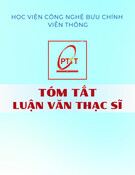

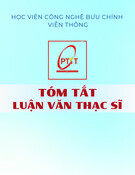

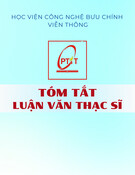

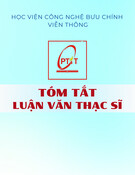

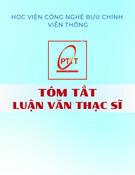




![Đề án Thạc sĩ: Tổ chức hoạt động văn hóa cho sinh viên Trường Cao đẳng Du lịch Hà Nội [Chuẩn nhất]](https://cdn.tailieu.vn/images/document/thumbnail/2025/20251202/kimphuong1001/135x160/91661764646353.jpg)





